The "Greatest Olympian Fallacy"
Why Metrics Matter.
Article - 09.08.2021
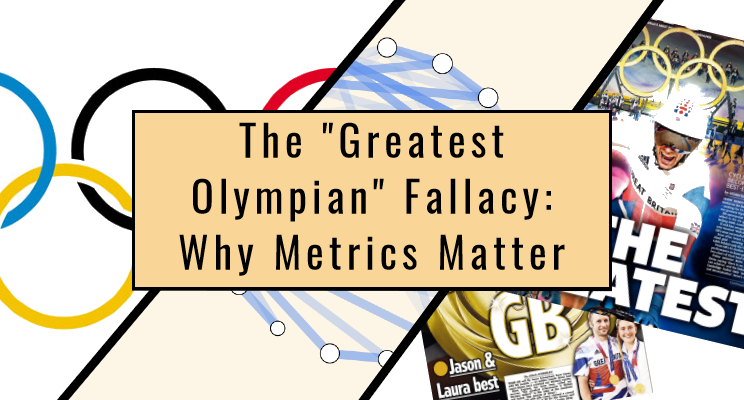
Who is the greatest Olympian? Michael Phelps? Larisa Latynina? And for Great Britain, maybe Bradley Wiggins, Jason Kenny, or Chris Hoy? These are our sporting superstars, the faces we see, and the voices we hear for sports opinions. And often these roles extend beyond this, either directly weighing in on the way funds are allocated or simply attracting more funds to their discipline thanks to their media attention.
To determine the “greats” from the merely talented we look to their respective medal hauls. Let’s look at the all-time (summer) Olympian medal hauls, but can you spot a problem with it?
https://en.wikipedia.org/wiki/List_of_multiple_Olympic_medalists
They're all from the same sports. Of the top 15, all but 3 are NOT from swimming or gymnastics. In this article, I want to illustrate the importance of metrics and debunk the notion that number of golds = greatness.
Metrics
A metric is just a measure of something. A metric is "good" if it helps us come to sound conclusions and "bad" if it leads us down the wrong path. Of course, this depends on our understanding of the metric, overly complex and it will be ignored, overly simplified and it will become useless. For example, when buying a car, one would compare miles/gallon (or km/litre) of the different options. That would give us a sense of how economic it would be to run. It goes without saying that we assume this metric is arrived at by the same means by each manufacturer. It’s not like one car was tested on a fine Spring morning in Holland and another was tested in a snowstorm in the Andes, right? That would be completely unfair.
When we compare numbers of medals between Olympians, we imply that they are all entered the same number of events. We can investigate this by plotting the number of athletes that two events share. The more connections a sport has, the better an athlete's chances of entering into multiple events. Here, I go through 4 sports: cycling, swimming, athletics, and gymnastics.
Note that all the following data will be from the 2016 Rio games (Tokyo data isn't available in a nice form yet so I worked with what I've got).
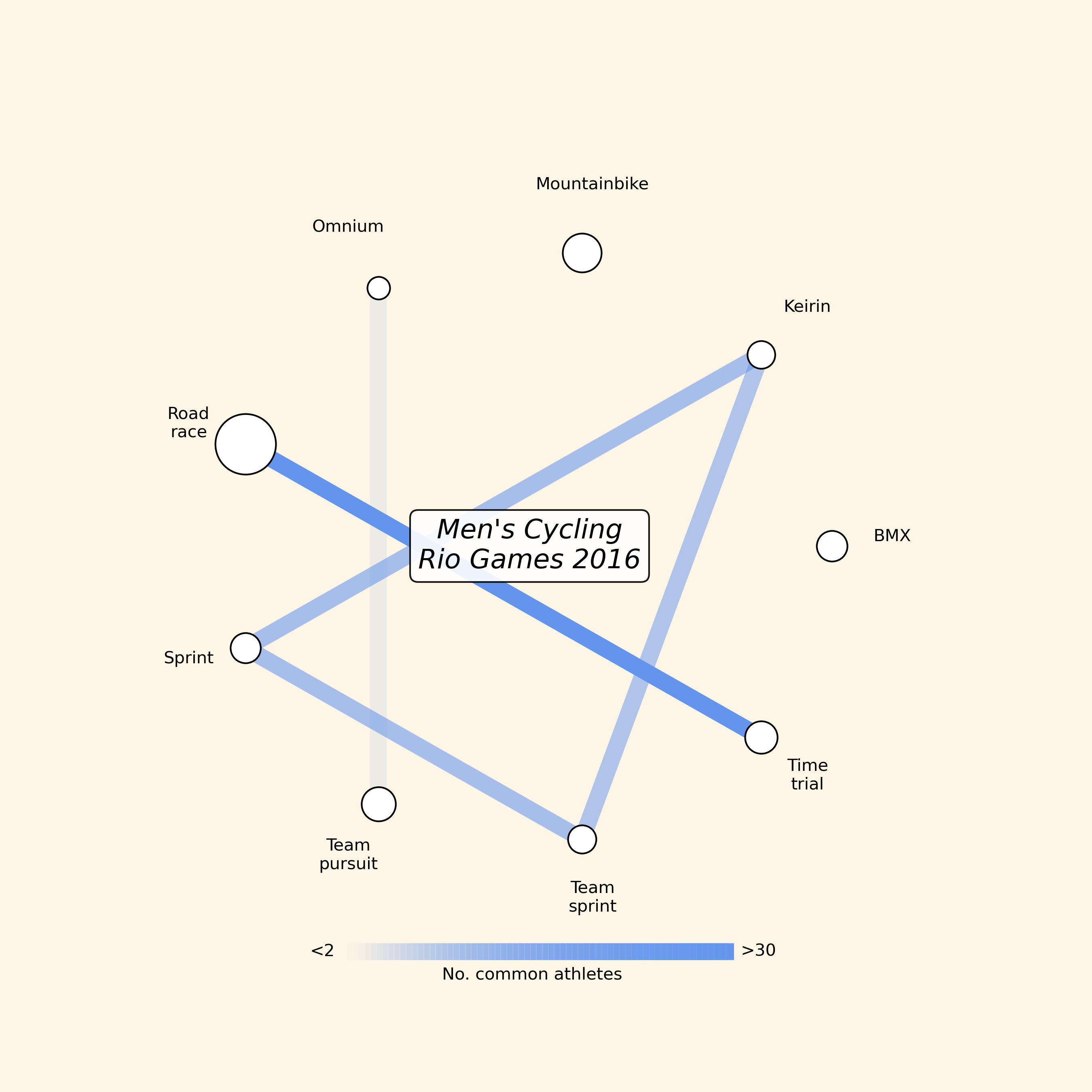
Cycling: Starting with the British favourite. Here we can see reasonable connectedness. If you did the sprint, there's a very good chance you also entered the team sprint and keirin. This is exactly what (Sir) Chris Hoy did for his 3 golds in 2008, as did Jack Kenny (CBE) in 2016.
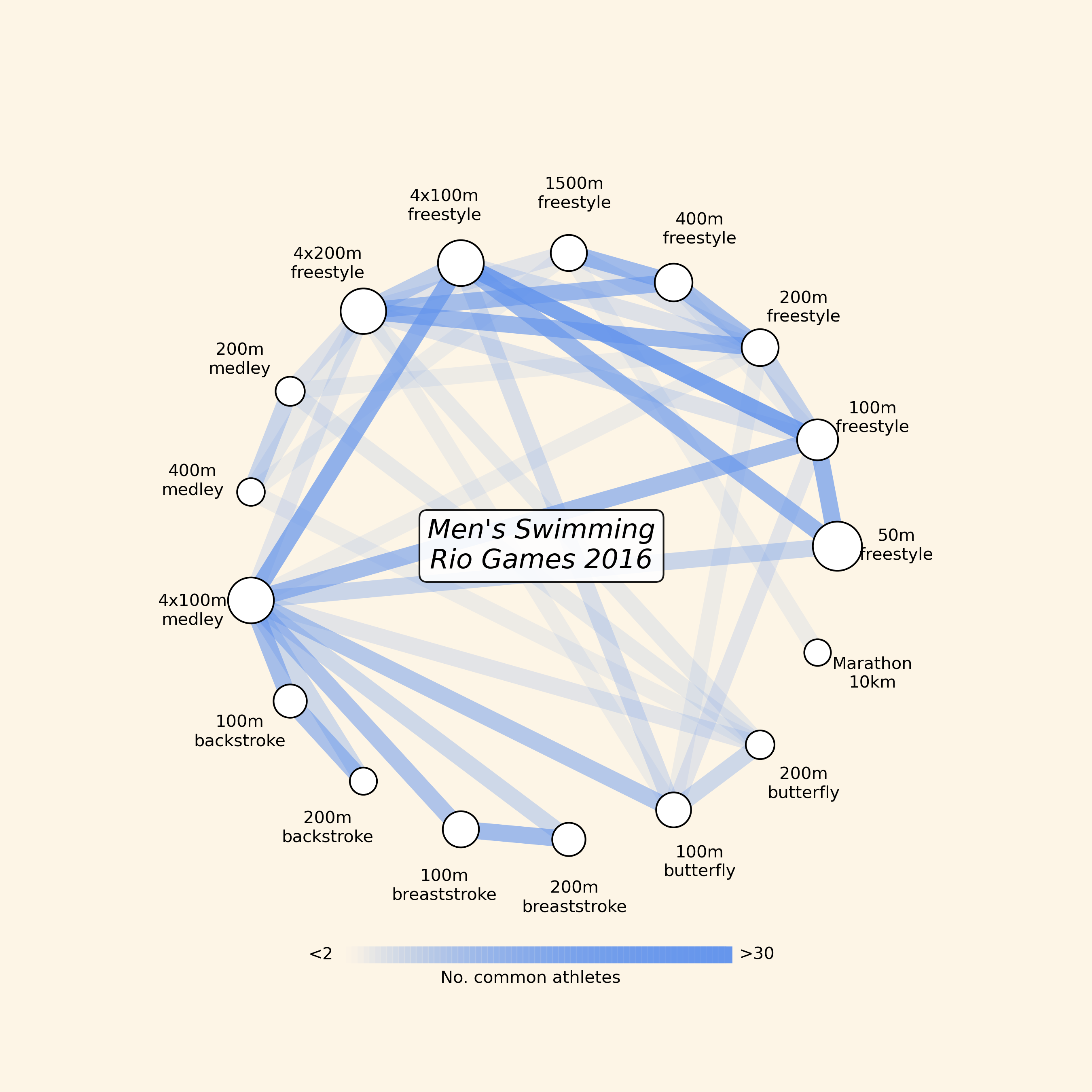
Swimming: First off, there were far more swimming events in Rio than cycling (34 versus 18) so we can a far higher absolute number of connections. That said, some of the events are staggeringly well connected. Take the 100m freestyle, if you enter this then you are almost definitely going to enter the 50m freestyle, the 4x100m freestyle, and 4x100m medley.
Full disclosure, swimming is a bugbear of mine, and the above graph entrenches my position. I think there are too many strokes across too many distances. Why must the stroke be prescribed? In no other sport do we have multiple sets of rules. It’s not like we have running “freestyle”, running with one hand behind your back, and backwards running.
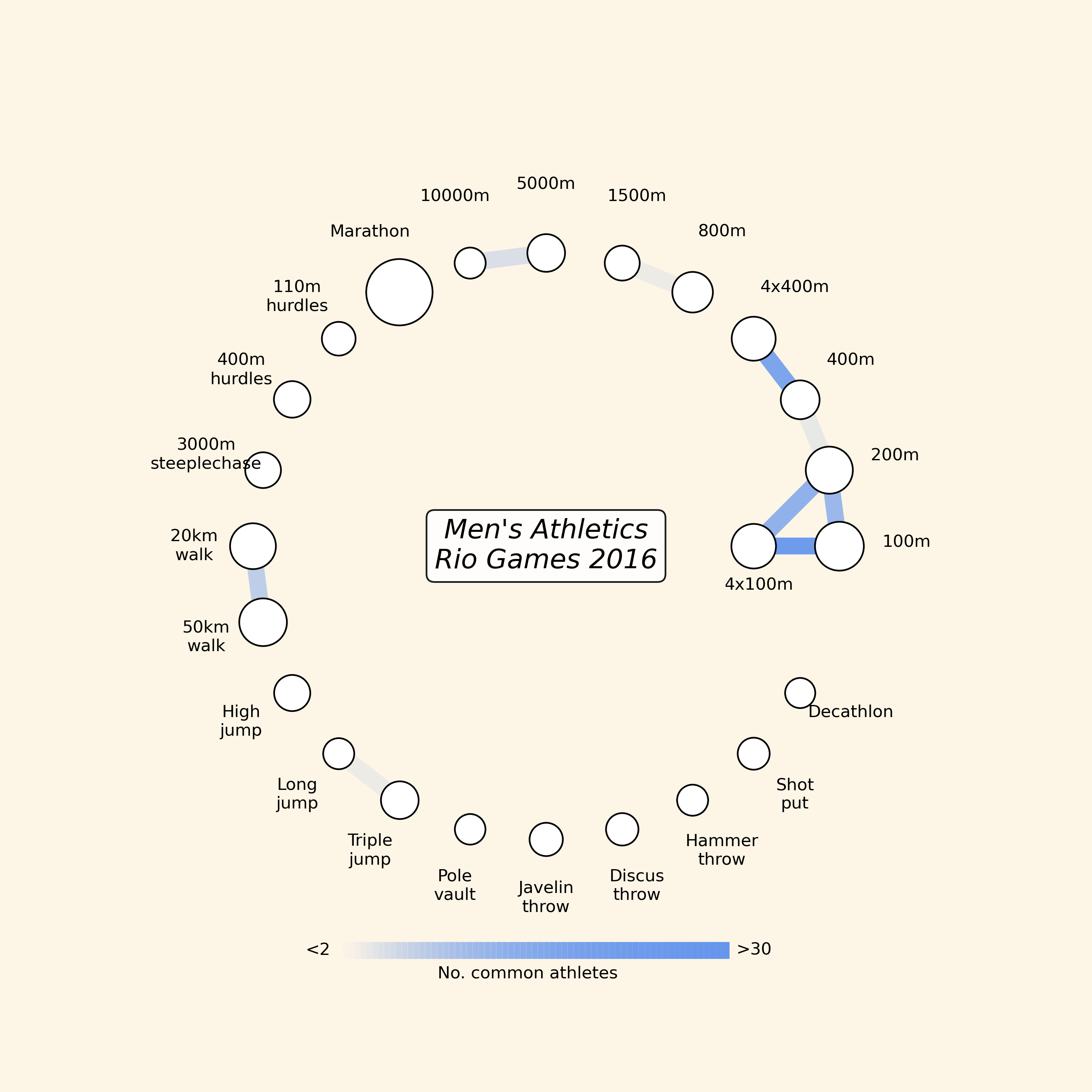
Athletics: Some readers might have read the above paragraph and be shouting wait! Athletics has both running and hurdles! I hope the athletics graph puts that argument to bed. There are absolutely no connections between the two. In athletics (which, remember, is a lot more than just running) the best approach for being a multi-medallist is to enter the 100m, 200m, and 4x100m relay. This is known as the “triple”, Usain Bolt famously achieved this in London 2012 and Rio 2016 (also in Beijing 2008 but the result was later revoked).
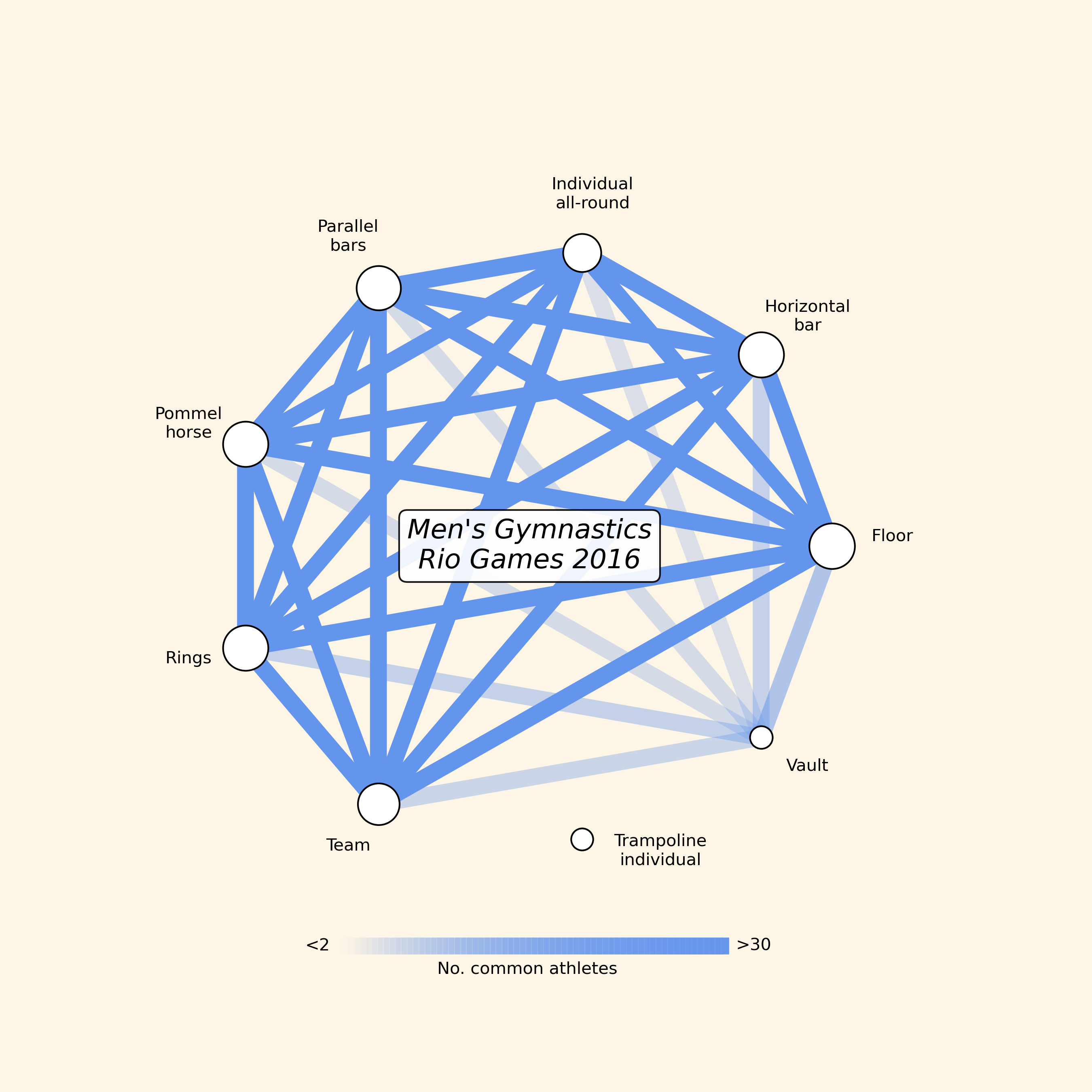
Gymnastics: Gymnastics is in a league of its own when it comes to connectedness. Essentially, your choices are to enter a) just the trampoline, b) just the vault, or c) all the other 7 events. I’ll say that again, a gymnast is likely to enter 7 events! How can we compare Olympians on number of medals when a hurdler enters 1 event and a gymnast enters 7?
I hope I’ve established that the Olympians are not competing on a level playing field when we compare them on medals earned (pun intended). To hammer the point home, there were 15 events in which an athlete could only medal once. Put it this way, you could be the greatest weightlifter there ever has been or ever will be, you could have revolutionised the sport and broken all the records, but you would still only walk away from the games with 1 medal.
The obvious question is: what is the right metric? Unfortunately, I don't have an answer for that. Perhaps some kind of weighting depending on how siloed the event is? All I know is that the metric of greatness is not medals won.
Beyond the Olympics
Metrics matter. They give us information to help form our opinions and decisions. As an example, let’s look at the power industry. A common metric for greening of the power sector is MW of wind capacity installed. In 2020, the UK installed 483MW of offshore wind[1]. This metric could be spun to say how green the UK is, and what a wonderful job the government is doing, after all that’s the 3rd highest in Europe! On the other hand, we could look at the latest figures from DUKES, which say that “Total renewables accounted for 13.6% of total energy consumption in 2020”[2]. Depending on which metric the public or decision makers are reading will, undoubtedly, influence their perception of how much action is being taken to combat climate change.
For this reason, we must always be critical of metrics, especially in the media which will stop at nothing to get a sensational story. Ask if the metric is appropriate, whether the right thing is being measured, whether proportional or absolute is better, etc. In the same vein, ask whether the metric gives a full enough picture, as the adage goes, whatever gets measured gets managed.
On a final note, be aware of what metrics you hold yourself to. You could find yourself performing in an event for which there is no medal, or worse, bought into someone else’s metric so much that you’ve forgotten what’s important to you (*cough cough* salary). At the risk of sounding overly positive, don't let that get you down, hopefully people in your field will give you the recognition you deserve. Better than that would be to free yourself from the need for recognition, but that doesn't particularly help when applying for funding.
In summary, reduce the number of Olympic swimming events.
Rory Morrison
Footnotes and references
All graphs my own
[1] https://windeurope.org/intelligence-platform/product/wind-energy-in-europe-in-2020-trends-and-statistics/
[2] https://assets.publishing.service.gov.uk/government/uploads/system/uploads/attachment_data/file/1007132/DUKES_2021_Chapters_1_to_7.pdf
Olympic data from here: https://www.olympiandatabase.com/index.php?id=417&L=1
This article was originally posted on LinkedIn, here
Python
The biggest part of this project was scraping the data. This was done using Selenium Chromedriver and a lot of manual manipulation to get the data into the right format. The data was taken from OlympianDatabase.com. I'm not going to post the code for this one as I don't like the idea of people scraping the s**t out of their site because of me!
The way I did the scraping was probably about 90% successful at picking up atheletes' names. Fortunately, the further an athlete got in an event, the better the chance their name was picked up as it would be listed multiple times on the event page, e.g. under "heat x", "semis", "final".
I originally tried to make the plots using "Networkx" and a non-circular layout. They turned out incomprehensible so I eventually used Networkx to get the node positions for a circular layout. I took that into a good ol' fashion Matplotlib figure and plotted the connections myself.
The reason why the scale starts at <2 is because there was one guy in the athletics who seemed to try about 10 different events. In each one he got nowhere so I decided to just filter that outlier out.
One thing I didn't mention in the original post is that the size of each node corresponds to the number of athletes in that event.